| Listing 1 - 10 of 18 | << page >> |
Sort by
|
Book
ISBN: 0841211167 Year: 1985 Publisher: Washington, District of Columbia : American Chemical Society,
Abstract | Keywords | Export | Availability | Bookmark
 Loading...
Loading...Choose an application
- Reference Manager
- EndNote
- RefWorks (Direct export to RefWorks)
Book
Year: 1969 Publisher: New York, NY : Marcel Dekker,
Abstract | Keywords | Export | Availability | Bookmark
 Loading...
Loading...Choose an application
- Reference Manager
- EndNote
- RefWorks (Direct export to RefWorks)
POLYMERIZATION --- RING-OPENING POLYMERIZATION --- POLYMERIZATION --- RING-OPENING POLYMERIZATION
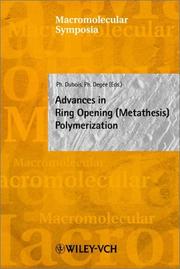
ISBN: 9783527301324 3527301321 Year: 2000 Publisher: Weinheim: Wiley-VCH,
Abstract | Keywords | Export | Availability | Bookmark
 Loading...
Loading...Choose an application
- Reference Manager
- EndNote
- RefWorks (Direct export to RefWorks)
Metathesis (Chemistry) --- Polymerization --- Ring-opening polymerization
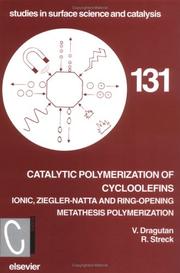
ISBN: 9780444895196 0444895191 9780080528625 0080528627 9786611019235 1281019232 Year: 2000 Publisher: Amsterdam ; New York : Elsevier,
Abstract | Keywords | Export | Availability | Bookmark
 Loading...
Loading...Choose an application
- Reference Manager
- EndNote
- RefWorks (Direct export to RefWorks)
This book covers the most important topics concerning cationic Ziegler-Natta and ring-opening metathesis polymerization of cycloolefins. The work describes the major pathways that cycloolefins can follow under the action of specific catalytic systems, essentially vinyl and ring-opening polymerization, both reaction types allowing the manufacture of distinct products with wide applicability in modern technologies. The comprehensive data available on this subject are logically and systematically selected and reviewed throughout 18 chapters, according to the basic catalytic processes involved, ty
Cycloalkenes. --- Ring-opening polymerization. --- Catalysis. --- Activation (Chemistry) --- Chemistry, Physical and theoretical --- Surface chemistry --- Polymerization --- Cycloolefins --- Alicyclic compounds --- Alkenes
Book
ISBN: 0471902675 9780471902676 Year: 1985 Publisher: Bucuresti Chichester New York Brisbane Editura Academiei Wiley
Abstract | Keywords | Export | Availability | Bookmark
 Loading...
Loading...Choose an application
- Reference Manager
- EndNote
- RefWorks (Direct export to RefWorks)
Polymeren en polymerisatie. --- Alkènes. --- Polymères et polymérisation. --- Olefins. --- Polymers and polymerization. --- Alkenen. --- Alkenes --- Ring-opening polymerization --- Metathesis (Chemistry)
Dissertation
Year: 2024 Publisher: Liège Université de Liège (ULiège)
Abstract | Keywords | Export | Availability | Bookmark
 Loading...
Loading...Choose an application
- Reference Manager
- EndNote
- RefWorks (Direct export to RefWorks)
Parmi les nombreuses applications possibles des élastomères, le domaine biomédical est l'un des plus exigeants en matière de propriétés mécaniques. En effet, selon l'application, les élastomères médicaux requièrent différentes caractéristiques telles que la ténacité, la durabilité mais aussi la dégradabilité. En effet dans ce domaine, la dégradabilité est une propriété majeure à étudier lorsque l'élastomère est destiné à être implanté dans le corps humain. L'offre d'élastomères dégradables non toxiques étant limitée, des alternatives doivent être trouvées pour combler cette lacune. Dans ce contexte, une classe émergente de polymères dégradables est étudiée : les polyphosphoesters. Ce type de polymère est prometteur pour le domaine biomédical grâce à sa structure semblable à celle de l'ADN, qui lui confère une grande biocompatibilité et une bonne dégradabilité. Cependant, les réseaux de polyphosphoesters ne présentent pas encore de propriétés élastiques. Par conséquent, l'objectif de ce mémoire était d'améliorer la capacité d'élongation des réseaux de polyphosphoester afin d'enrichir les caractéristiques que cette classe de polymères peut offrir. A partir d'un modèle théorique qui prédit les propriétés mécaniques des réseaux chimiques, deux stratégies synthétiques ont été menées afin d'améliorer les propriétés élastomériques des matériaux. Tout d'abord, des copolymères de polyphosphate photo- réticulables ont été synthétisés par ouverture de cycle organocatalysée avec différentes architectures dans le but d'améliorer les propriétés mécaniques d’élongation. Deuxièmement, nous avons posé la pierre angulaire de la polymérisation de monomères phosphates cycliques à six pièces par ROP, car nous pensons que les polymères résultants pourraient constituer une valeur ajoutée pour obtenir des propriétés élastiques améliorées. Dans ce travail, nous rapportons le premier élastomère de polyphosphoester avec un allongement maximal avant rupture atteignant 180%, alors que la dernière valeur publiée ne dépassait pas 15%. Nous avons également établi des relations entre la microstructure des chaînes de polymères et leurs propriétés physiques, telles que le module d'Young et l'élongation maximale. Ces résultats ouvrent la voie à des applications biomédicales sans précédent des polyphosphoesters et leur permet de révéler tout leur potentiel. Among numerous possible applications of elastomers, the biomedical field is one of the most demanding regarding mechanical properties. Indeed, according to the application, medical elastomers require different adjustable features such as toughness, durability but also degradability. For this specific field, degradability is a major property to study when the elastomer is destined to be implanted in human bodies. Since the offer for non-toxic degradable elastomers is slim, alternatives have to be investigated. In order to bridge the gap, a rising class of degradable polymers is being studied: polyphosphoesters. This type of polymer is promising for the biomedical field thanks to its DNA-like structure that provides it with great biocompatibility and degradability. Though, polyphosphoester networks do not exhibit elastomeric properties yet. Therefore, the aim of this thesis was to improve the elongation capacity of polyphosphoester networks in order to enrich the features this class of polymers can offer. Starting from a theoretical model that predicts the mechanical properties of chemical networks, two synthetic strategies were conducted to provide enhanced elastomer properties to the materials. Firstly, photocrosslinkable polyphosphate copolymers were synthesized by organocatalyzed ROP with different architectures with the aim of seeking for improvements of mechanical properties. Secondly, we laid the cornerstone for the polymerization of six-membered cyclic phosphate monomers by ROP since we believe the resulting polymers could be an added value to reach enhanced elastic properties. In this work we report the first polyphosphoester elastomer with a maximum elongation at break reaching 180% where the last published elongation did not exceed 15%. We further established relationships between the microstructure of the polymer chains and their physical properties, such as Young’s modulus and maximum elongation. These results pave the way for unprecedented biomedical applications of polyphosphoesters and reveal their full potential.
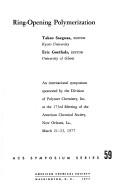
ISBN: 084120392X Year: 1977 Publisher: Washington, DC : ACS,
Abstract | Keywords | Export | Availability | Bookmark
 Loading...
Loading...Choose an application
- Reference Manager
- EndNote
- RefWorks (Direct export to RefWorks)
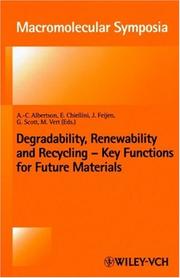
ISSN: 10221360 ISBN: 3527299041 9783527299041 Year: 1999 Volume: 144 Publisher: Weinheim : Wiley-VCH,
Abstract | Keywords | Export | Availability | Bookmark
 Loading...
Loading...Choose an application
- Reference Manager
- EndNote
- RefWorks (Direct export to RefWorks)
Polymers --- Plastics --- Plastic scrap --- Biodegradation --- Polymers - Biodegradation --- Plastics - Biodegradation --- Aliphatic polyesters --- Biodegradable polymers --- Chitin --- Decomposition --- Polysaccharides --- Recycling of polymeric materials --- Ring-opening polymerization
Dissertation

Year: 2016 Publisher: Liège Université de Liège (ULiège)
Abstract | Keywords | Export | Availability | Bookmark
 Loading...
Loading...Choose an application
- Reference Manager
- EndNote
- RefWorks (Direct export to RefWorks)
Le polylactide (PLA) est un polymère biosourcé, biodégradable et biocompatible, ce qui en fait un matériau en pleine expansion. Il est utilisé pour des applications de commodité telles que l’emballage ou des applications à plus haute valeur ajoutée telles que les systèmes de libération contrôlée de principes actifs ou encore la préparation d’échafaudages pour l’ingénierie tissulaire. Pour ce travail, l’octoate d’étain, catalyseur présentant une activité catalytique importante a été utilisé pour assurer une polymérisation par ouverture de cycle suffisamment rapide du L-lactide en PLLA de manière continue. Cette synthèse continue a été effectuée dans une extrudeuse bivis corotative présentant un diamètre de 11 mm et un ratio L/D de 40. Compte tenu de la petite taille de cette extrudeuse, divers arrangements de la configuration des vis et du fourreau ont dû être réalisés avec pour objectif d’augmenter le temps de résidence très limité dans le réacteur. Afin d’ensuite améliorer les propriétés du PLLA synthétisé, différentes modifications ont été apportées au mélange réactionnel : ajout d’un initiateur, d’un co-catalyseur, diminution de la quantité d’octoate d’étain. De plus, divers post-traitements ont également été réalisés. Il a finalement été possible de réaliser le PLLA avec une conversion moléculaire de 80000 g/mol et une polydispersité de 1,5 avec un rapport molaire catalyseur/monomère de 1/5000 et du polyéthylène glycol comme initiateur. Enfin, une analyse des risques liés aux défaillances possibles de l’extrudeuse a été réalisée dans l’’optique d’une mise à l’échelle industrielle du procédé de synthèse.
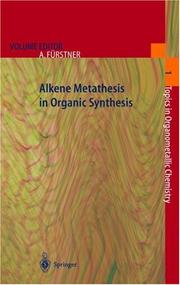
ISBN: 3540642544 354069708X 9783540642541 Year: 1998 Volume: 1 Publisher: Berlin : Springer,
Abstract | Keywords | Export | Availability | Bookmark
 Loading...
Loading...Choose an application
- Reference Manager
- EndNote
- RefWorks (Direct export to RefWorks)
The tremendous progress in olefin metathesis achieved during the last decade can hardly be overestimated. Due to the development of a new generation of well defined and high-performance organometallic catalysts, this reaction is rapidly evolving into one of the most versatile tools for advanced organic chemistry, natural product synthesis, fine chemical production and polymer sciences. Written by some of the leading experts in this field, this monograph intends to familiarize the reader with the most exciting developments and frontiers in this flourishing field of chemistry research.
Alkenes --- Ring-opening polymerization --- Metathesis (Chemistry) --- Transition metal catalysts --- Alkenes. --- Ring-opening polymerization. --- Transition metal catalysts. --- Polymérisation par ouverture de cycle --- Métaux de transition --- Catalyseurs --- Metathesis (Chemistry). --- Organic chemistry. --- Inorganic chemistry. --- Chemical engineering. --- Polymers . --- Organic Chemistry. --- Inorganic Chemistry. --- Industrial Chemistry/Chemical Engineering. --- Polymer Sciences. --- Polymere --- Polymeride --- Polymers and polymerization --- Macromolecules --- Chemistry, Industrial --- Engineering, Chemical --- Industrial chemistry --- Engineering --- Chemistry, Technical --- Metallurgy --- Inorganic chemistry --- Chemistry --- Inorganic compounds --- Organic chemistry
| Listing 1 - 10 of 18 | << page >> |
Sort by
|

 Search
Search Feedback
Feedback About UniCat
About UniCat  Help
Help News
News